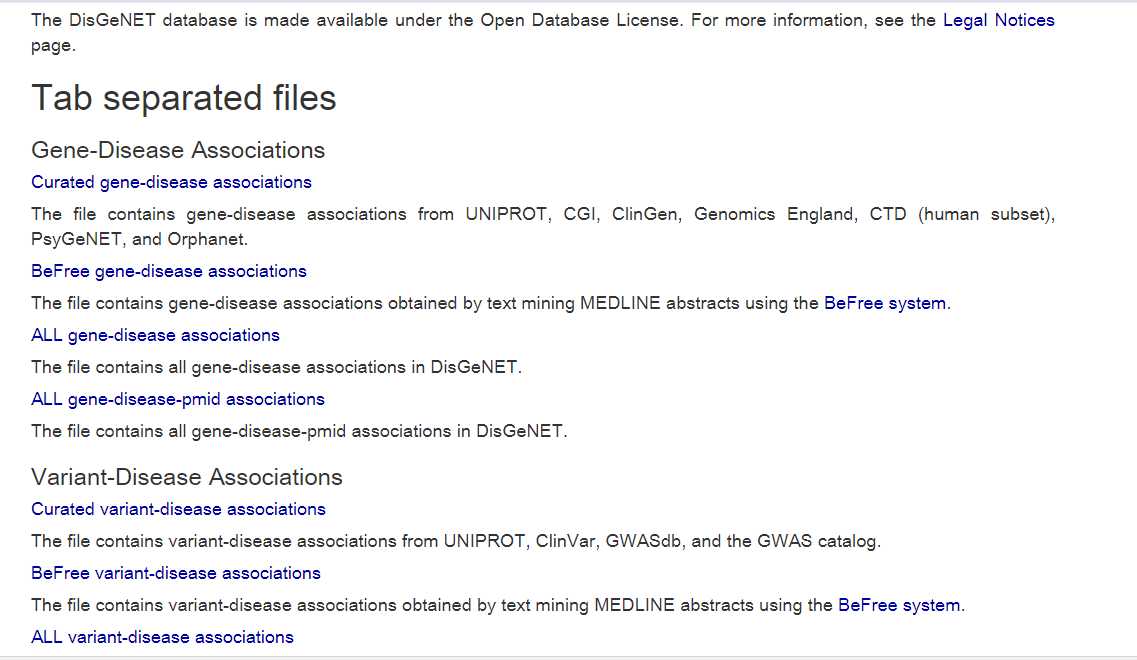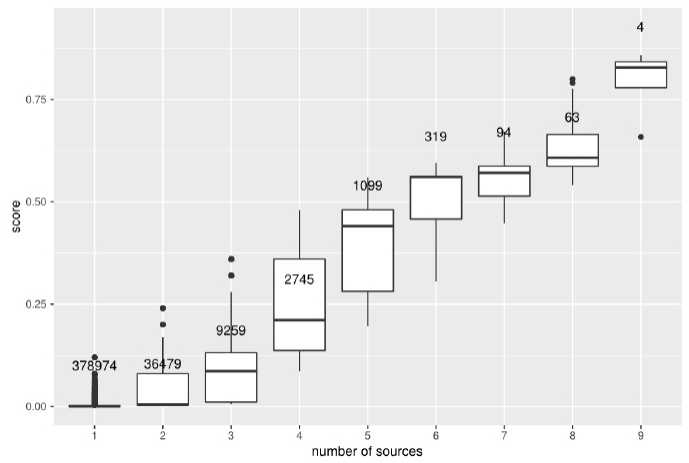标签:lin 分数 init 获得 soc symbols auto normal form
DisGeNET数据库 整合了多个数据库的gene-disease associations (GDAs)和大量的文献,并且采用文本挖掘技术对孟德尔疾病、复杂疾病和环境性疾病进行了相关性分析。具体技术包括对基因-疾病词汇的mapping、DisGeNET本体分析。
使用的数据源如下:
Curated Data:
UNIPROT、CTD、CLINVAR、ORPHANET、GWAS CATALOG
Predicted Data:
CTD、MGD、RGD
Literature Data:
GAD、LHGDN、BeFree Data
Variant Data:
dbSNP、EXAC、1000 Genomes Project、Ensembl
打开数据的下载界面如图所示:
.
一.数据的理解
文件均为制表符分隔文件
1.首先我们关注 Gene-Disease Associations
下面我们来区分一下三种不用的文件类型

1.来自UniProt,CGI,ClinGen,Genomics England Panel App,PsyGeNET,Orphanet,HPO和CTD(人类数据)的基因疾病协会
2.使用BeFree系统获得的基因 - 疾病关联
3.DisGeNET中的所有基因 - 疾病关联
The columns in the files are: geneId -> NCBI Entrez Gene Identifier :NCBI Entrez基因标识符 geneSymbol -> Official Gene Symbol:官方基因符号 DSI -> The Disease Specificity Index for the gene :该基因的疾病特异性指数 DPI -> The Disease Pleiotropy Index for the gene :该基因的疾病多效性指数 diseaseId -> UMLS concept unique identifier:UMLS概念唯一标识符 diseaseName -> Name of the disease:疾病名称 diseaseType -> The DisGeNET disease type: disease, phenotype and group:谱系疾病类型:疾病、表型、类群 diseaseClass -> The MeSH disease class(es):MeSH疾病类(es) diseaseSemanticType -> The UMLS Semantic Type(s) of the disease:本病的UMLS语义类型 score -> DisGENET score for the Gene-Disease association:基因疾病协会的DisGENET评分 EI -> The Evidence Index for the Gene-Disease association:基因疾病协会的证据指数 YearInitial -> First time that the Gene-Disease association was reported:这是基因疾病关系首次被报道的时间 YearFinal -> Last time that the Gene-Disease association was reported:这是基因疾病关系最后一次被报道的时间 NofPmids -> Total number of publications reporting the Gene-Disease association:报告基因疾病关系的出版物总数 NofSnps -> Total number of SNPs associated to the Gene-Disease association:与基因疾病关系相关的snp总数 source -> Original source reporting the Gene-Disease association:基因疾病关系的原始报告
2.下面分析Variant-Disease Associations
curated_variant_disease_associations.tsv.gz => Variant-Disease associations from UniProt, ClinVar, GWASdb and the GWAS Catalog befree_variant_disease_associations.tsv.gz => Variant-Disease associations obtained using BeFree System all_variant_disease_associations.tsv.gz => All Variant-Disease associations in DisGeNET The columns in the files are: snpId -> dbSNP variant Identifier chromosome -> Chromosome of the variant position -> Position in chromosome DSI -> The Disease Specificity Index for the variant DPI -> The Disease Pleiotropy Index for the variant diseaseId -> UMLS concept unique identifier diseaseName -> Name of the disease diseaseType -> The DisGeNET disease type: disease, phenotype and group diseaseClass -> The MeSH disease class(es) diseaseSemanticType -> The UMLS Semantic Type(s) of the disease score -> DisGENET score for the Variant-Disease association EI -> The Evidence Index for the Variant-Disease association YearInitial -> First time that the Variant-Disease association was reported YearFinal -> Last time that the Variant-Disease association was reported NofPmids -> Total number of publications reporting the Variant-Disease association source -> Original source reporting the Variant-Disease association
3.gene_disease_pmid:PMID(PubMed唯一标识码,PubMed Unique Identifier),用于为PubMed搜索引擎中收录的生命科学和医学等领域的文献编号
all_gene_disease_pmid_associations.tsv.gz => All Gene-Disease-PMID associations in DisGeNET The columns in the files are: geneId -> NCBI Entrez Gene Identifier geneSymbol -> Official Gene Symbol DSI -> The Disease Specificity Index for the gene DPI -> The Disease Pleiotropy Index for the gene diseaseId -> UMLS concept unique identifier diseaseName -> Name of the disease diseaseType -> The DisGeNET disease type: disease, phenotype and group diseaseClass -> The MeSH disease class(es) diseaseSemanticType -> The UMLS Semantic Type(s) of the disease score -> DisGENET score for the Gene-Disease association EI -> The Evidence Index for the Gene-Disease association YearInitial -> First time that the Gene-Disease association was reported YearFinal -> Last time that the Gene-Disease association was reported pmid -> Publication reporting the Gene-Disease association source -> Original source reporting the Gene-Disease association
4.variant_disease_pmid
all_variant_disease_pmid_associations.tsv.gz => All Variant-Disease-PMID associations in DisGeNET The columns in the files are: snpId -> dbSNP variant Identifier chromosome -> Chromosome of the variant position -> Position in chromosome DSI -> The Disease Specificity Index for the variant DPI -> The Disease Pleiotropy Index for the variant diseaseId -> UMLS concept unique identifier diseaseName -> Name of the disease diseaseType -> disease, phenotype, or group diseaseType -> The DisGeNET disease type: disease, phenotype and group diseaseClass -> The MeSH disease class(es) score -> DisGENET score for the Variant-Disease association YearInitial -> First time that the Variant-Disease association was reported YearFinal -> Last time that the Variant-Disease association was reported pmid -> Publication reporting the Variant-Disease association source -> Original source reporting the Variant-Disease association 5.disease_mappings.tsv.gz => Mappings from UMLS concept unique identifier to disease vocabularies: DO, EFO, HPO, ICD9CM, MSH, NCI, OMIM, and ORDO 6.variant_to_gene_mappings.tsv.gz => Variant mapped to their corresponding genes, according to dbSNP. The columns in the files are: snpId -> dbSNP variant Identifier geneId -> NCBI Entrez Gene Identifier geneSymbol -> Official Gene Symbol
7.UMLS CUI to several disease vocabularies
The file contains the mappings of DisGeNET genes (Entrez Gene Identifiers) to UniProt entriesUMLS CUI to several disease vocabularies
8.Other FilesFile with BeFree gene-disease-pmid associations for PubAnnotation BeFree gene-disease-pmid associations for Pubannotation
二.各个数据库统计
三. DisGeNET 打分系统
根据报告关联的来源数量分配DisGeNET分数

四. 疾病特异性指数Disease Specificity Index(DSI)
where:
- Nd is the number of diseases associated to the gene
- NT is the total number of diseases in DisGeNET (13,674)
The DSI ranges from 0 to 1.
DSI = 0 implies that the gene is associated only to phenotypes.
Example: TNF, associated to more than 1,500 diseases, has a DSI of 0.247, while IDH3A is associated to one disease, with a DSI of 1.
五.疾病多效应指数Disease Pleiotropy Index(DPI)
where:
- Ndc is the number of the different MeSH disease classes of the diseases associated to the gene
- NTC is the total number of MeSH diseases classes in DisGeNET (27)
The DPI ranges from 0 to 1.
DPI = 0 implies that the gene is associated only to phenotypes, or that the associated diseases do not map to any MeSH classes.
Example: gene KCNE2 is associated to 38 diseases and 10 phenotypes. 36 out of the 38 diseases have a MeSH disease class. The 36 diseases are associated to 10 different MeSH classes. The DPI index for KCNE2 = 10/27*100 ~ 0.37. Nevertheless, gene APOE, associated to more than 700 diseases, of different disease classes, has a DPI of 1.
六. 词汇mapping(Vocabulary Mapping)
Diseases:
The vocabulary used for diseases in the current release of DisGeNET is the Unified Medical Language System®(UMLS®) vocabulary. The repositories of gene-disease associations use different disease vocabularies, OMIM® terms for diseases from UniProt, CTDTM, and MGD; MeSH terms used by CTDTM, LHGDN, and RGD, UMLS® Concept Unique Identifiers (CUIs) from CLINVAR; Orphanet identifiers are mapped using Orphanet cross-references. Disease names from GAD and the GWAS Catalog are normalized using the UMLS Metathesaurus. We also used UMLS® Metathesaurus® concept structure to map MIM and MeSH terms to UMLS® CUIs.
Genes:
For human genes, HGNC symbols (used for some entries in GAD), and Uniprot accession numbers (used by Uniprot) are converted to NCBI Entrez gene identifiers using an in house dictionary that crossreferences HGNC, Uniprot and NCBI-Gene information. For mapping of mouse and rat genes, we used files ftp://ftp.informatics.jax.org/pub/reports/HOM_MouseHumanSequence.rpt, and ftp://rgd.mcw.edu/pub/data_release/RGD_ORTHOLOGS.txt both with information of orthology from MGD and RGD, respectively to map rat and mouse Entrez gene identifiers to human Entrez identifiers. We discarded the relationships when a human ortholog of the mouse or rat gene could not be found.
七. The DisGeNET Association Type Ontology
八. 数据属性
疾病
·the disease name, provided by theUMLS®Metathesaurus®
·theUMLS®semantic types
·theMeSHclass: We classify the diseases according the MeSH hierarchy using 23 upper level concepts of the MeSH tree branch C (Diseases) plus three concepts of the F branch (Psychiatry and Psychology: "Behavior and Behavior Mechanisms", "Psychological Phenomena and Processes", and "Mental Disorders").
·The top level concepts from theHuman Disease Ontology.
·The DisGeNET disease type:disease,phenotype and group.
UMLS semantic types:
- Disease or Syndrome
- Neoplastic Process
- Acquired Abnormality
- Anatomical Abnormality
- Congenital Abnormality
- Mental or Behavioral Dysfunction
UMLS® semantic types:
- Pathologic Function
- Sign or Symptom
- Finding
- Laboratory or Test Result
- Individual Behavior
- Clinical Attribute
- Organism Attribute
- Organism Function
- Organ or Tissue Function
- Cell or Molecular Dysfunction
These classifications were manually checked. In addition, disease entries referring to disease groups such as "Cardiovascular Diseases", "Autoimmune Diseases", "Neurodegenerative Diseases, and "Lung Neoplasms" were classified as disease group.
Removed terms considered as diseases by other sources, but are not strictly diseases, such as terms belonging to the following UMLS® semantic types:
- Gene or Genome
- Genetic Function
- Immunologic Factor
- Injury or Poisoning
These attributes are shown in the different views of the browser, and they are all shown in the Disease Tab.
基因
·the official gene symbol, from theNCBI
·the NCBI Official Full Name
·theUniprotaccession
·the top level Panther protein class.
·the top level Reactome pathways.
·the Specificity Index (SI)
·the Pleiotropy Index (PI)
突变
·The position in the chromosome
·The reference and alternative alleles
·The class of the variant: SNP, deletion, insertion, indel, somatic SNV, substitution, sequence alteration, and tandem repeat
·The allelic frequency according to the 1000 Genomes Project
·The allelic frequency according to the Exome Aggregation Consortium
·The most severe consequence type according to the VEP
·Links to dbSNP
·Links to ClinVar
·Links to Ensembl
基因-疾病相关性
·theDisGeNET score
·the DisGeNET Gene-Disease Association Type
·the publication(s) that reports the gene-disease association, with the Pubmed Identifier
·a representative sentence from the publication describing the association between the gene and the disease (If a representative sentence is not found, we provide the title of the paper)
·the original source reporting the Gene-Disease Association
·For some sources, we provide the variant(s) associated to the gene-disease association
九. 提供Cytoscape插件
DisGeNET Cytoscape App
十.支持本地下载
可以下载tab格式的文档(Curated、BeFree gene-disease associations和publications)
提供RDF Linked Dataset
同时query大量的数据,还支持python、perl、R脚本。
还提供mapping功能:
1. UniProt Downloads DisGeNET genes -> UniProt entries
2. UMLS CUI -> MeSH Identifier
标签:lin 分数 init 获得 soc symbols auto normal form
原文地址:https://www.cnblogs.com/wangshicheng/p/11018801.html